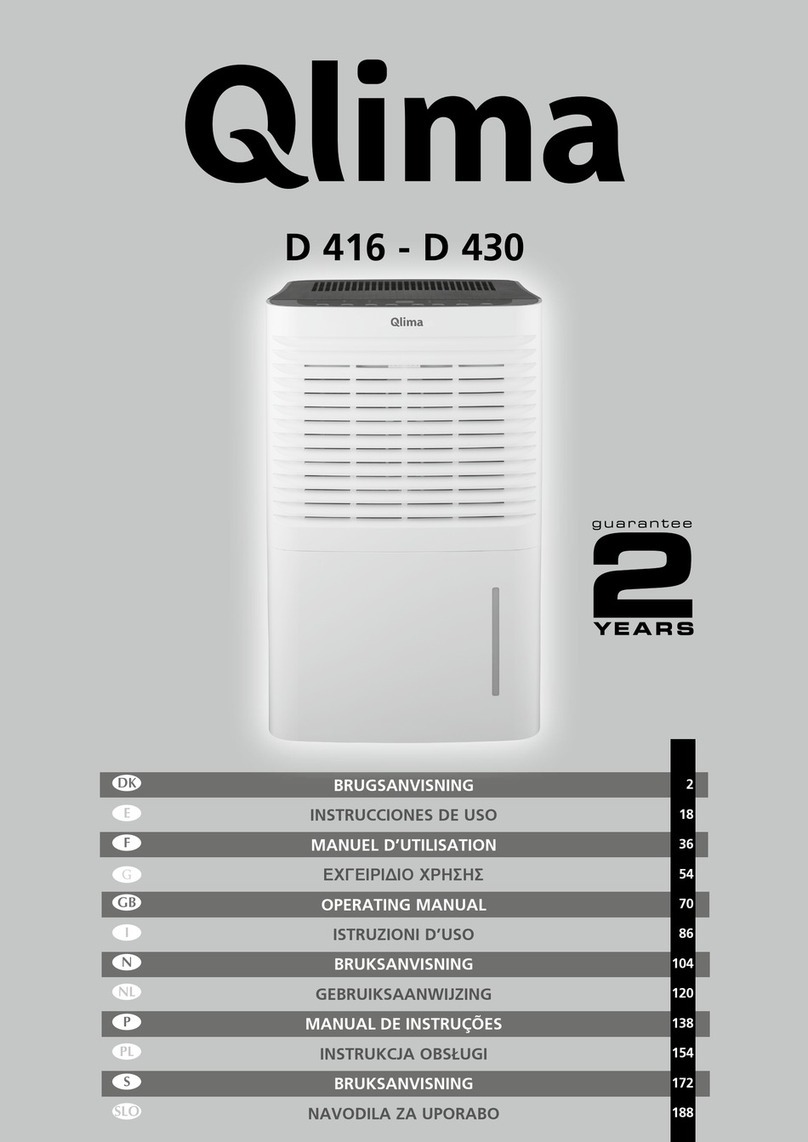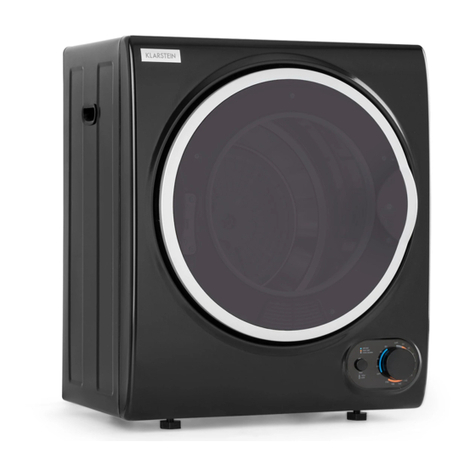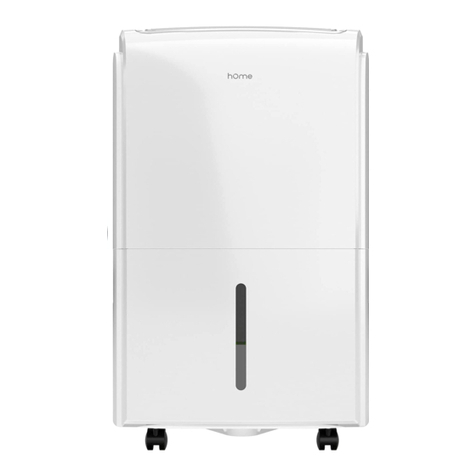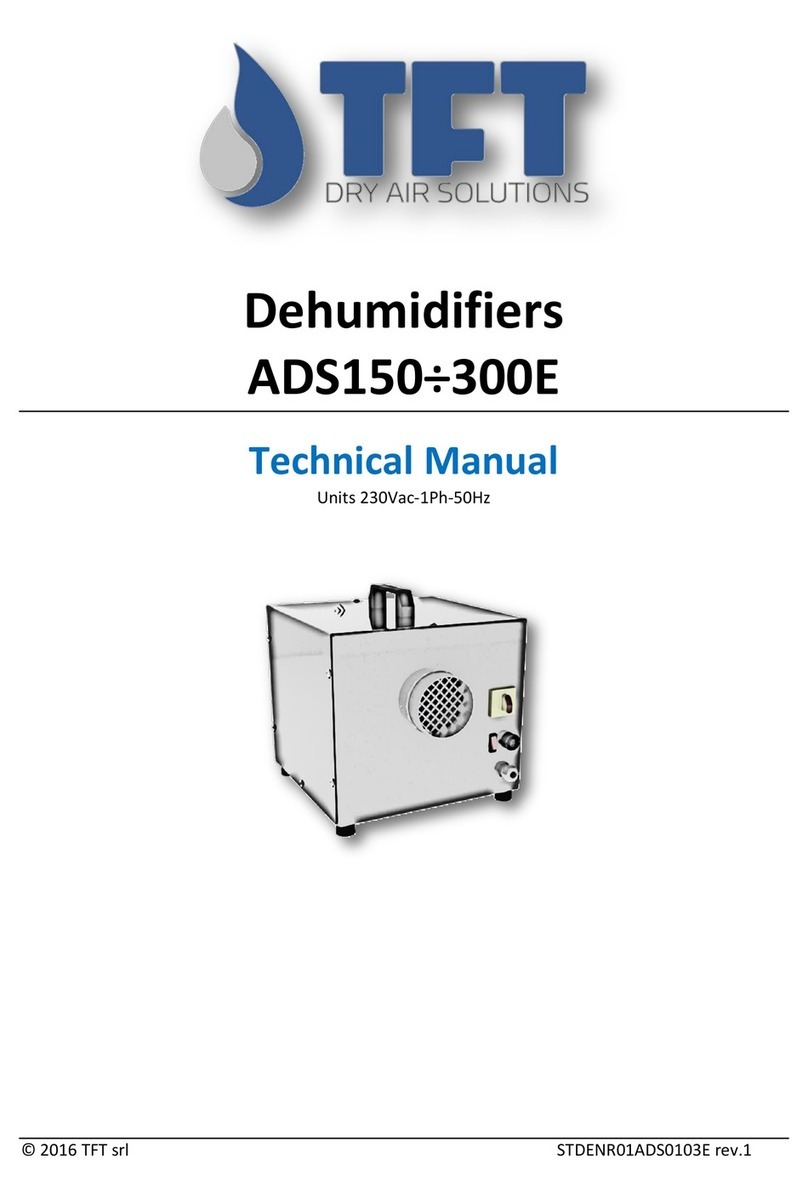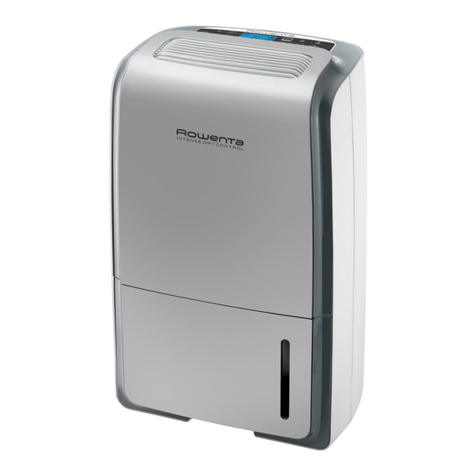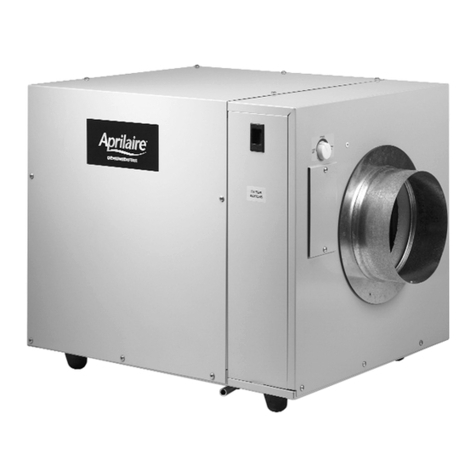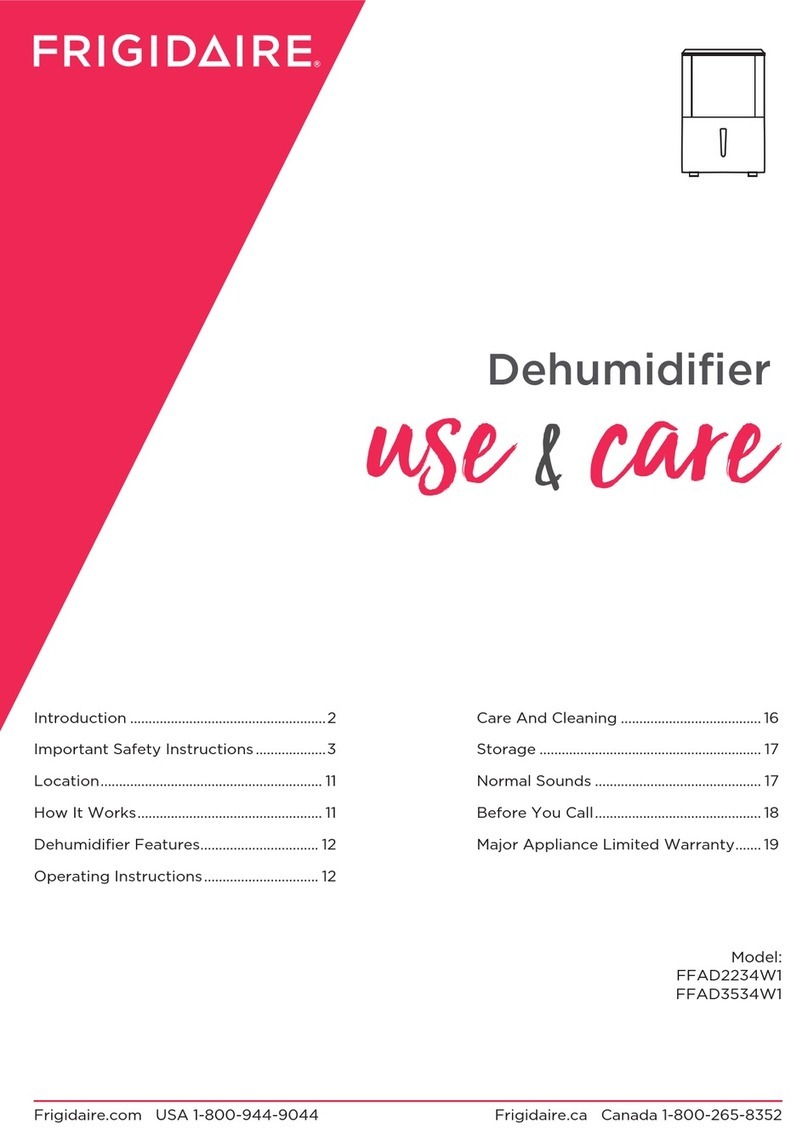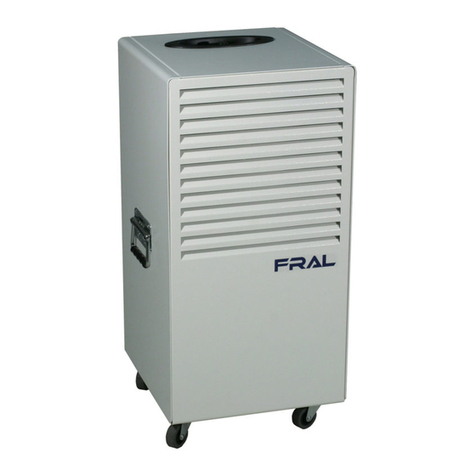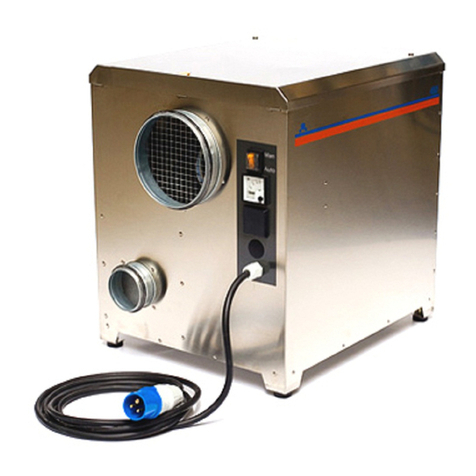Solt GGSAD16W User manual

E S S E N T I A L S FOR LIFE
User
Manual
MODEL
GGSAD16W
Dehumidifier

2
For future reference, please record the following information which can be found on
the rating plate and the date of purchase which can be found on your sales invoice.
STORE DETAILS
STORE NAME
|
ADDRESS
|
TELEPHONE
|
PURCHASE DATE
|
PRODUCT DETAILS
MODEL NO.
|
SERIAL NO.*
|
Purchase Details

3
Welcome Congratulations on purchasing
your new Dehumidifier!
The Sôlt brand is proudly
distributed within Australia by
Residentia Group Pty Ltd.
Please refer to the warranty card at the rear of this manual
for information regarding your product’s parts and labour
warranty, or visit us online at www.residentia.group
At Residentia Group, we are customer obsessed and our
Support Team are there to ensure you get the most out of
your appliance. Should you want to learn more about your
rangehood features, and importantly taking care of your
appliance when cleaning, our Support Team are here
to help.
You can use our online Support Centre at anytime by
visiting http://support.residentiagroup.com.au, or you can
contact us via calling us on 1300 11 HELP (4357).
It is important that you read through the following use and
care manual thoroughly to familiarise yourself with the
installation and operation requirements of your appliance
to ensure optimum performance.
Again, thank you for choosing an Sôlt appliance and we
look forward to being of service to you.
Kind Regards,
The Residentia Team
Residentia Group
—
Head Office.
165 Barkly Ave
Burnley
Victoria 3121
Australia
—
ACN.
600 546 656
—
Online.
residentia.group

4
This page
is intentionally
left blank

Contents 2Purchase Details
3Welcome
6General Safety Instructions
12 Your Dehumidifier
13 Installation
14 Getting Started
17 Operation Instructions
18 FAQs & Troubleshooting Guide
19 Other Useful Information
20 Technical Specifications
22 Warranty Information
Sôlt recommends the use of original spare parts. When contacting our customer service team, please ensure
that you have the following information at hand (which can be found on your appliances’ rating plate).
— Model Number
— Serial Number
Customer Care

6
READ CAREFULLY AND KEEP FOR FUTURE REFERENCE
Read this manual thoroughly before first use, even if
you are familiar with this type of product. The safety
precautions enclosed herein reduce the risk of fire, electric
shock and injury when correctly adhered to. Make sure
you understand all instructions and warnings.
Keep the manual in a safe place for future reference,
along with the completed warranty card and purchase
receipt. If you sell or transfer ownership of this product,
pass on these instructions to the new owner.
Always follow basic safety precautions and accident
prevention measures when using an electrical appliance,
including the following:
ELECTRICAL SAFETY AND CORD HANDLING
–Voltage: Before turning on the Dehumidifier, ensure
the electrical voltage and circuit frequency correspond
to those indicated on the appliance.
–Socket: Ensure your electrical outlet is properly
installed and earthed and complies with your local
electrical safety requirements.
–Moisture: To reduce the risk of electrocution, never
operate the appliance with wet hands; never
submerge it in water or spill liquids into it. Do not use it
in a bathroom or laundry, or where it can be splashed
with water.
–Power supply cord: Do not kink or damage the
cord. Do not pull the cord or place it near a heat
source. Always unwind the cord completely to avoid
overheating. Run the cord in such a way so that no
one will trip over it.
–Extension cord/adaptor: Do not use this appliance
with an extension cord or power adaptor.
–Damaged cord: If the supply cord is damaged, do
not use the appliance. A damaged power supply cord
must be replaced by the manufacturer or its service
agent or a similarly qualified person in order to avoid
a hazard. Contact our after sales support centre.
–WARNING: Do not use when damaged! In case of
damage, switch off the appliance, unplug it and
contact our after sales support centre. Do not pick
up or operate a damaged appliance, or after it
malfunctions or has been dropped or damaged in
any manner.
–Power button: Always use the on/off button on the
control panel to turn the product on or off. Never
simply switch the product on or off by plugging it into
or unplugging it from the wall socket.
–Disconnect: Turn off the unit first and then unplug
it when it is not in use and before maintenance or
cleaning, but do not unplug it when it is in operation,
as this could create a spark and cause a fire. Grip by
the plug, do not pull by the cord when disconnecting.
–RCD: The installation of a residual current device
(safety switch) is recommended to provide additional
safety protection when using electrical appliances. It
is advisable that a safety switch with a rated residual
operating current not exceeding 30mA be installed in
the electrical circuit supplying the appliance. See your
electrician for professional advice.
– Never try to open the housing, modify or alter the
product in any way.
USAGE CONDITIONS AND RESTRICTIONS
–Intended use: This appliance is intended for air
conditioning domestic environments. It is not suitable
for commercial, industrial or trade use. Do not use it
for any other purpose (such as cooling food, etc.) and
only use it as described in this manual.
–Common sense: These instructions are not intended to
cover every possible condition and situation. As with
any electrical appliance, common sense and caution
are therefore always recommended when installing,
operating and maintaining the unit.
–No outdoor use: Do not use the unit outdoors.
It is for indoor use only.
–Usage restriction: This appliance is not intended
for use by persons (including children) with reduced
physical, sensory or mental capabilities, or lack of
experience and knowledge, unless they have been
given supervision or instruction concerning use of
the appliance in a safe way and understand the
hazards involved.
–No external timer: This appliance is not intended to
be used with an external timer or a separate remote
control system.
–WARNING: Do not cover! Do not cover the
Dehumidifier or obstruct any air inlet or outlet grilles.
Obstructing these openings causes a fire hazard,
reduces the operating efficiency and may lead to
malfunction or damage.
–Air outlets: Do not insert any objects, or your fingers,
into the air outlet, and make sure to warn children of
the dangers.
–Children: Supervise children to ensure they do not
play with the appliance. Close supervision is necessary
when any appliance is used by or near children.
Cleaning and user maintenance shall not be made by
children without supervision.
General Safety Instructions

7
–Unattended: Do not leave the appliance unattended
when in use.
–Attachments: The use of attachments not
recommended or sold by the manufacturer may cause
fire, electric shock or injury.
–Moving the appliance: When moving the
Dehumidifier, always turn off and disconnect the
power supply, and move it slowly.
– Never place any objects containing liquid, such as
flower vases or drinks, on top of the product.
– Never handle the product with wet hands or
while barefoot.
– Switch off and unplug the product when it is not in use.
–WARNING! If the product should tip over, immediately
turn it off and unplug it.
– Always maintain a 1m clearance around the
Dehumidifier for any combustible materials or
flammable gases. Do not place the appliance near
a heat source.
–WARNING! Never remove the water storage tank
during operation.
– Never drink the water captured within the
Dehumidifier, it contains contaminants and may make
you sick.
CLEANING AND MAINTENANCE
–Disconnect: Make sure the appliance is disconnected
from the power supply when it will not be used for a
long time and before carrying out any cleaning
or maintenance.
–Air filter: Keep the air filter clean. Do not use the unit
without the air filters fitted. Using it without air filters
could cause an excessive accumulation of dust or
waste on the inner parts of the device with possible
subsequent failures.
–Service and repair: The Dehumidifier has no
user-serviceable parts contained inside. Do not
attempt to disassemble, modify or conduct repairs on
this unit. It has been built in accordance with relevant
safety and performance standards. An electrical
specialist must carry out all repairs. Contact our after
sales support line for advice on service.
INSTALLATION
–Proper installation: Install the appliance according
to the instructions in this manual and national wiring
regulations. Improper installation may result in the
risk of fire, electric shock and/or injury. We assume no
responsibility for any eventual damages caused by
improper installation or faulty use.
–Upright position: Place the unit on a flat surface to
reduce the risk of it tipping over. Do not tilt the unit,
always keep it upright. If the unit has not been kept
upright (such as during storage), wait for at least
24 hours before operation.
–Obstructions: Do not locate the Dehumidifier where
furniture or other objects can obstruct the airflow.
–Do not cover: Do not cover the Dehumidifier or
obstruct any air inlet or outlet grilles. Obstructing
these openings causes a fire hazard, reduces the
operating efficiency and may lead to malfunction or
damage.
–Chemicals: Do not install the Dehumidifier in
environments where the air could contain gas, oil
or sulphur. Do not let chemical substances come
into contact with the unit. Do not use the unit in the
presence of flammable substances or vapour such as
alcohol, insecticides, petrol etc.
–Heat: Do not install the Dehumidifier near sources
of heat, or exposed to direct sunlight.
–Room size: The unit is designed for use in a room
of 29–44m² size.
–Clearances: Always keep a clearance of at least
100cm furniture and curtains and 20cm from walls.
This symbol shows that this appliance uses a flammable refrigerant
(R290). If the refrigerant is leaked and exposed to an external ignition
source, there is a risk of fire.

8
General Safety Instructions (Continued)
WARNING FOR USING R32R290 REFRIGERANT
– Do not use means to accelerate the defrosting
process or to clean, other than those recommended
by the manufacturer.
– The appliance shall be stored in a room without
continuously operating ignition sources (for example:
open flames, an operating gas appliance or an
operating electric heater).
– Do not pierce or burn.
– Be aware that the refrigerants may not contain
an odour.
– Appliance should be installed, operated and stored in
a room with a floor area according to the amount of
refrigerant to be charged. For specific information on
the type of gas and the amount, please refer to the
relevant label on the unit itself.
– Appliance should be installed, operated and stored in
a room with a floor area larger than 4 m².
– Compliance with national gas regulations shall be
observed.
– Keep ventilation openings clear of obstruction.
– The appliance shall be stored so as to prevent
mechanical damage from occurring.
– A warning that the appliance shall be stored in a
well-ventilated area where the room size corresponds
to the room area as specified for operation.
– Any person who is involved with working on or
breaking into a refrigerant circuit should hold
a current valid certificate from an industry-
accredited assessment authority, which authorises
their competence to handle refrigerants safely in
accordance with an industry recognised
assessment specification.
– Servicing shall only be performed as recommended by
the equipment manufacturer. Maintenance and repair
requiring the assistance of other skilled personnel shall
be carried out under the supervision of the person
competent in the use of flammable refrigerants.
– The appliance shall be stored in a room without
continuously operating open flames (for example an
operating gas appliance) and ignition sources (for
example an operating electric heater).
Explanation of symbols displayed on the unit
(For the unit adopts R32/R290 Refrigerant only):
Safety
Precautions
Page 6
WARNING for Using R32/R290 Refrigerant
Do not use means to accelerate the defrosting process or to clean, other than those recommended by
the manufacturer.
The appliance shall be stored in a room without continuously operating ignition sources (for example:
open flames, an operating gas appliance or an operating electric heater).
Do not pierce or burn.
Be aware that the refrigerants may not contain an odour.
Compliance with national gas regulations shall be observed.
Keep ventilation openings clear of obstruction.
The appliance shall be stored so as to prevent mechanical damage from occurring.
A warning that the appliance shall be stored in a well-ventilated area where the room size corresponds
to the room area as specified for operation.
Any person who is involved with working on or breaking into a refrigerant circuit should hold a current
valid certificate from an industry-accredited assessment authority, which authorises their competence
to handle refrigerants safely in accordance with an industry recognised assessment specification.
Servicing shall only be performed as recommended by the equipment manufacturer. Maintenance
and repair requiring the assistance of other skilled personnel shall be carried out under the supervision
of the person competent in the use of flammable refrigerants.
The appliance shall be stored in a room without continuously operating open flames (for example an
operating gas appliance) and ignition sources (for example an operating electric heater).
Appliance should be installed, operated and stored in a room with a floor area according to the amount
of refrigerant to be charged. For specific information on the type of gas and the amount, please refer
to the relevant label on the unit itself.
Appliance should be installed, operated and stored in a room with a floor area larger than 4 m .
Caution: Risk of fire/
flammable materials
Explanation of symbols displayed on the unit(For the
unit adopts R32/R290 Refrigerant only):
WARNING
CAUTION
CAUTION
CAUTION
This symbol shows that this appliance used a
flammable refrigerant. If the refrigerant is leaked and
exposed to an external ignition source, there is a risk
of fire.
This symbol shows that the operation manual
should be read carefully.
This symbol shows that a service personnel should be
handling this equipment with reference to the
installation manual.
This symbol shows that information is available such
as the operating manual or installation manual.
2
WARNING This symbol shows that this appliance
used a flammable refrigerant. If the
refrigerant is leaked and exposed to
an external ignition source, there is a
risk of fire.
Safety
Precautions
Page 6
WARNING for Using R32/R290 Refrigerant
Do not use means to accelerate the defrosting process or to clean, other than those recommended by
the manufacturer.
The appliance shall be stored in a room without continuously operating ignition sources (for example:
open flames, an operating gas appliance or an operating electric heater).
Do not pierce or burn.
Be aware that the refrigerants may not contain an odour.
Compliance with national gas regulations shall be observed.
Keep ventilation openings clear of obstruction.
The appliance shall be stored so as to prevent mechanical damage from occurring.
A warning that the appliance shall be stored in a well-ventilated area where the room size corresponds
to the room area as specified for operation.
Any person who is involved with working on or breaking into a refrigerant circuit should hold a current
valid certificate from an industry-accredited assessment authority, which authorises their competence
to handle refrigerants safely in accordance with an industry recognised assessment specification.
Servicing shall only be performed as recommended by the equipment manufacturer. Maintenance
and repair requiring the assistance of other skilled personnel shall be carried out under the supervision
of the person competent in the use of flammable refrigerants.
The appliance shall be stored in a room without continuously operating open flames (for example an
operating gas appliance) and ignition sources (for example an operating electric heater).
Appliance should be installed, operated and stored in a room with a floor area according to the amount
of refrigerant to be charged. For specific information on the type of gas and the amount, please refer
to the relevant label on the unit itself.
Appliance should be installed, operated and stored in a room with a floor area larger than 4 m .
Caution: Risk of fire/
flammable materials
Explanation of symbols displayed on the unit(For the
unit adopts R32/R290 Refrigerant only):
WARNING
CAUTION
CAUTION
CAUTION
This symbol shows that this appliance used a
flammable refrigerant. If the refrigerant is leaked and
exposed to an external ignition source, there is a risk
of fire.
This symbol shows that the operation manual
should be read carefully.
This symbol shows that a service personnel should be
handling this equipment with reference to the
installation manual.
This symbol shows that information is available such
as the operating manual or installation manual.
2
CAUTION This symbol shows that the operation
manual should be read carefully.
Safety
Precautions
Page 6
WARNING for Using R32/R290 Refrigerant
Do not use means to accelerate the defrosting process or to clean, other than those recommended by
the manufacturer.
The appliance shall be stored in a room without continuously operating ignition sources (for example:
open flames, an operating gas appliance or an operating electric heater).
Do not pierce or burn.
Be aware that the refrigerants may not contain an odour.
Compliance with national gas regulations shall be observed.
Keep ventilation openings clear of obstruction.
The appliance shall be stored so as to prevent mechanical damage from occurring.
A warning that the appliance shall be stored in a well-ventilated area where the room size corresponds
to the room area as specified for operation.
Any person who is involved with working on or breaking into a refrigerant circuit should hold a current
valid certificate from an industry-accredited assessment authority, which authorises their competence
to handle refrigerants safely in accordance with an industry recognised assessment specification.
Servicing shall only be performed as recommended by the equipment manufacturer. Maintenance
and repair requiring the assistance of other skilled personnel shall be carried out under the supervision
of the person competent in the use of flammable refrigerants.
The appliance shall be stored in a room without continuously operating open flames (for example an
operating gas appliance) and ignition sources (for example an operating electric heater).
Appliance should be installed, operated and stored in a room with a floor area according to the amount
of refrigerant to be charged. For specific information on the type of gas and the amount, please refer
to the relevant label on the unit itself.
Appliance should be installed, operated and stored in a room with a floor area larger than 4 m .
Caution: Risk of fire/
flammable materials
Explanation of symbols displayed on the unit(For the
unit adopts R32/R290 Refrigerant only):
WARNING
CAUTION
CAUTION
CAUTION
This symbol shows that this appliance used a
flammable refrigerant. If the refrigerant is leaked and
exposed to an external ignition source, there is a risk
of fire.
This symbol shows that the operation manual
should be read carefully.
This symbol shows that a service personnel should be
handling this equipment with reference to the
installation manual.
This symbol shows that information is available such
as the operating manual or installation manual.
2
CAUTION This symbol shows that a service
personnel should be handling this
equipment with reference to the
installation manual.
Safety
Precautions
Page 6
WARNING for Using R32/R290 Refrigerant
Do not use means to accelerate the defrosting process or to clean, other than those recommended by
the manufacturer.
The appliance shall be stored in a room without continuously operating ignition sources (for example:
open flames, an operating gas appliance or an operating electric heater).
Do not pierce or burn.
Be aware that the refrigerants may not contain an odour.
Compliance with national gas regulations shall be observed.
Keep ventilation openings clear of obstruction.
The appliance shall be stored so as to prevent mechanical damage from occurring.
A warning that the appliance shall be stored in a well-ventilated area where the room size corresponds
to the room area as specified for operation.
Any person who is involved with working on or breaking into a refrigerant circuit should hold a current
valid certificate from an industry-accredited assessment authority, which authorises their competence
to handle refrigerants safely in accordance with an industry recognised assessment specification.
Servicing shall only be performed as recommended by the equipment manufacturer. Maintenance
and repair requiring the assistance of other skilled personnel shall be carried out under the supervision
of the person competent in the use of flammable refrigerants.
The appliance shall be stored in a room without continuously operating open flames (for example an
operating gas appliance) and ignition sources (for example an operating electric heater).
Appliance should be installed, operated and stored in a room with a floor area according to the amount
of refrigerant to be charged. For specific information on the type of gas and the amount, please refer
to the relevant label on the unit itself.
Appliance should be installed, operated and stored in a room with a floor area larger than 4 m .
Caution: Risk of fire/
flammable materials
Explanation of symbols displayed on the unit(For the
unit adopts R32/R290 Refrigerant only):
WARNING
CAUTION
CAUTION
CAUTION
This symbol shows that this appliance used a
flammable refrigerant. If the refrigerant is leaked and
exposed to an external ignition source, there is a risk
of fire.
This symbol shows that the operation manual
should be read carefully.
This symbol shows that a service personnel should be
handling this equipment with reference to the
installation manual.
This symbol shows that information is available such
as the operating manual or installation manual.
2
CAUTION This symbol shows that information
is available such as the operating
manual or installation manual
Caution: Risk of fire /
flammable materials

9
Transport of equipment containing flammable refrigerants
See transport regulations
Marking of equipment using signs
See local regulations
Disposal of equipment using flammable refrigerants
See national regulations.
Storage of equipment/appliances
The storage of equipment should be in accordance with
the manufacturer’s instructions.
Storage of packed (unsold) equipment
Storage package protection should be constructed such
that mechanical damage to the equipment inside the
package will not cause a leak of the refrigerant charge.
The maximum number of pieces of equipment permitted
to be stored together will be determined by local
regulations.
Information on servicing
1. Checks to the area
Prior to beginning work on systems containing flammable
refrigerants, safety checks are necessary to ensure
that the risk of ignition is minimised. For repair to the
refrigerating system, the following precautions shall be
complied with prior to conducting work on the system.
2. Work procedure
Work shall be undertaken under a controlled
procedure so as to minimise the risk of a flammable
gas or vapour being present while the work is being
performed.
3. General work area
All maintenance staff and others working in the local
area shall be instructed on the nature of work being
carried out. Work in confined spaces shall be avoided.
The area around the workspace shall be sectioned off.
Ensure that the conditions within the area have been
made safe by control of flammable material.
4. Checking for presence of refrigerant
The area shall be checked with an appropriate
refrigerant detector prior to and during work, to ensure
the technician is aware of potentially flammable
atmospheres. Ensure that the leak detection
equipment being used is suitable for use with
flammable refrigerants, i.e. non-sparking, adequately
sealed or intrinsically safe.
5. Presence of fire extinguisher
If any hot work is to be conducted on the refrigeration
equipment or any associated parts, appropriate fire
extinguishing equipment shall be available to hand.
Have a dry powder or CO2 fire extinguisher adjacent
to the charging area.
6. No ignition sources
No person carrying out work in relation to a
refrigeration system which involves exposing any
pipe work that contains or has contained flammable
refrigerant shall use any sources of ignition in such a
manner that it may lead to the risk of fire or explosion.
All possible ignition sources, including cigarette
smoking, should be kept sufficiently far away from the
site of installation, repairing, removing and disposal,
during which flammable refrigerant can possibly
be released to the surrounding space. Prior to work
taking place, the area around the equipment is to be
surveyed to make sure that there are no flammable
hazards or ignition risks. No Smoking signs shall be
displayed.
7. Ventilated area
Ensure that the area is in the open or that it is
adequately ventilated before breaking into the system
or conducting any hot work. A degree of ventilation
shall continue during the period that the work is
carried out. The ventilation should safely disperse any
released refrigerant and preferably expel it externally
into the atmosphere.
8. Checks to the refrigeration equipment
Where electrical components are being changed,
they shall be fit for the purpose and to the correct
specification. At all times the manufacturer’s
maintenance and service guidelines shall be followed.
If in doubt consult the manufacturer’s technical
department for assistance. The following checks
shall be applied to installations using flammable
refrigerants:
The charge size is in accordance with the room size
within which the refrigerant containing parts are
installed;
The ventilation machinery and outlets are operating
adequately and are not obstructed;
If an indirect refrigerating circuit is being used, the
secondary circuit shall be checked for the presence
of refrigerant; Marking to the equipment continues
to be visible and legible. Markings and signs that are
illegible shall be corrected;
Refrigeration pipe or components are installed in a
position where they are unlikely to be exposed to any
substance which may corrode refrigerant containing
components, unless the components are constructed
of materials which are inherently resistant to being
corroded or are suitably protected against being
so corroded.

10
Information on servicing (Continued)
9. Checks to electrical devices
Repair and maintenance to electrical components shall
include initial safety checks and component inspection
procedures. If a fault exists that could compromise
safety, then no electrical supply shall be connected to
the circuit until it is satisfactorily dealt with. If the fault
cannot be corrected immediately but it is necessary to
continue operation, an adequate temporary solution
shall be used. This shall be reported to the owner of the
equipment so all parties are advised.
Initial safety checks shall include:
That capacitors are discharged: this shall be done in a
safe manner to avoid possibility of sparking;
That there no live electrical components and wiring
are exposed while charging, recovering or purging the
system; That there is continuity of earth bonding.
10. Repairs to sealed components
• During repairs to sealed components, all electrical
supplies shall be disconnected from the equipment
being worked upon prior to any removal of sealed
covers, etc. If it is absolutely necessary to have an
electrical supply to equipment during servicing, then
a permanently operating form of leak detection shall
be located at the most critical point to warn of a
potentially hazardous situation.
• Particular attention shall be paid to the following to
ensure that by working on electrical components, the
casing is not altered in such a way that the level of
protection is affected. This shall include damage to
cables, excessive number of connections, terminals
not made to original specification, damage to seals,
incorrect fitting of glands, etc. Ensure that apparatus
is mounted securely. Ensure that seals or sealing
materials have not degraded such that they no
longer serve the purpose of preventing the ingress of
flammable atmospheres. Replacement parts shall be in
accordance with the manufacturer’s specifications.
NOTE: The use of silicon sealant may inhibit the
effectiveness of some types of leak detection
equipment. Intrinsically safe components do not have
to be isolated prior to working on them.
11. Repair to intrinsically safe components
Do not apply any permanent inductive or capacitance
loads to the circuit without ensuring that this will
not exceed the permissible voltage and current
permitted for the equipment in use. Intrinsically safe
components are the only types that can be worked on
while live in the presence of a flammable atmosphere.
The test apparatus shall be at the correct rating.
Replace components only with parts specified by the
manufacturer. Other parts may result in the ignition of
refrigerant in the atmosphere from a leak.
12. Cabling
Check that cabling will not be subject to wear, corrosion,
excessive pressure, vibration, sharp edges or any other
adverse environmental effects. The check shall also take
into account the effects of aging or continual vibration
from sources such as compressors or fans.
13. Detection of flammable refrigerants
Under no circumstances shall potential sources of
ignition be used in the searching for or detection of
refrigerant leaks. A halide torch (or any other detector
using a naked flame) shall not be used.
14. Leak detection methods
The following leak detection methods are deemed
acceptable for systems containing flammable
refrigerants. Electronic leak detectors shall be used
to detect flammable refrigerants, but the sensitivity
may not be adequate, or may need re-calibration.
(Detection equipment shall be calibrated in a
refrigerant-free area.) Ensure that the detector is not
a potential source of ignition and is suitable for the
refrigerant used. Leak detection equipment shall be
set at a percentage of the LFL of the refrigerant and
shall be calibrated to the refrigerant employed and
the appropriate percentage of gas (25 % maximum)
is confirmed. Leak detection fluids are suitable for
use with most refrigerants but the use of detergents
containing chlorine shall be avoided as the chlorine
may react with the refrigerant and corrode the copper
pipe-work. If a leak is suspected, all naked flames shall
be removed/ extinguished. If a leakage of refrigerant
is found which requires brazing, all of the refrigerant
shall be recovered from the system, or isolated (by
means of shut off valves) in a part of the system
remote from the leak. Oxygen free nitrogen (OFN) shall
then be purged through the system both before and
during the brazing process.
15. Removal and evacuation
When breaking into the refrigerant circuit to make
repairs or for any other purpose conventional
procedures shall be used. However, it is important
that best practice is followed since flammability is
a consideration. The following procedure shall be
adhered to:
Remove refrigerant; Purge the circuit with inert gas;
Evacuate; Purge again with inert gas; Open the circuit
by cutting or brazing.
The refrigerant charge shall be recovered into the
correct recovery cylinders. The system shall be flushed
with OFN to render the unit safe. This process may
need to be repeated several times. Compressed air or
oxygen shall not be used for this task. Flushing shall be
achieved by breaking the vacuum in the system with
OFN and continuing to fill until the working pressure is
achieved, then venting to atmosphere, and
General Safety Instructions (Continued)

11
finally pulling down to a vacuum. This process shall be
repeated until no refrigerant is within the system.
When the final OFN charge is used, the system shall be
vented down to atmospheric pressure to enable work to
take place. This operation is absolutely vital if brazing
operations on the pipe-work are to take place. Ensure
that the outlet for the vacuum pump is not close to any
ignition sources and there is ventilation available.
16. Charging procedures
In addition to conventional charging procedures, the
following requirements shall be followed. Ensure that
contamination of different refrigerants does not occur
when using charging equipment. Hoses or lines shall
be as short as possible to minimise the amount of
refrigerant contained in them.
Cylinders shall be kept upright.
Ensure that the refrigeration system is earthed prior to
charging the system with refrigerant.
Label the system when charging is complete
(if not already).
Extreme care shall be taken not to overfill the
refrigeration system. Prior to recharging the system
it shall be pressure tested with OFN. The system shall
be leak tested on completion of charging but prior to
commissioning. A follow up leak test shall be carried
out prior to leaving the site.
17. Decommissioning
Before carrying out this procedure, it is essential
that the technician is completely familiar with the
equipment and all its detail. It is recommended good
practice that all refrigerants are recovered safely.
Prior to the task being carried out, an oil and
refrigerant sample shall be taken in case analysis is
required prior to re-use of reclaimed refrigerant. It is
essential that electrical power is available before the
task is commenced.
a. Become familiar with the equipment and its operation.
b. Isolate system electrically.
c. Before attempting the procedure ensure that:
Mechanical handling equipment is available, if
required, for handling refrigerant cylinders;All
personal protective equipment is available and being
used correctly; The recovery process is supervised at
all times by a competent person; Recovery equipment
and cylinders conform to the appropriate standards.
d. Pump down refrigerant system, if possible.
e. If a vacuum is not possible, make a manifold so that
refrigerant can be removed from various parts of
the system.
f. Make sure that cylinder is situated on the scales before
recovery takes place.
g. Start the recovery machine and operate in accordance
with manufacturer’s instructions.
h. Do not overfill cylinders. (No more than 80 % volume
liquid charge).
i. Do not exceed the maximum working pressure of the
cylinder, even temporarily.
j. When the cylinders have been filled correctly and the
process completed, make sure that the cylinders and
the equipment are removed from site promptly and all
isolation valves on the equipment are closed off.
k. Recovered refrigerant shall not be charged into
another refrigeration system unless it has been
cleaned and checked.
18. Labelling
Equipment shall be labelled stating that it has been
de-commissioned and emptied of refrigerant. The
label shall be dated and signed. Ensure that there
are labels on the equipment stating the equipment
contains flammable refrigerant.
19. Recovery
When removing refrigerant from a system, either for
servicing or decommissioning, it is recommended good
practice that all refrigerants are removed safely. When
transferring refrigerant into cylinders, ensure that only
appropriate refrigerant recovery cylinders are employed.
Ensure that the correct number of cylinders for holding
the total system charge is available. All cylinders to be
used are designated for the recovered refrigerant and
labelled for that refrigerant (i.e. special cylinders for
the recovery of refrigerant). Cylinders shall be complete
with pressure relief valve and associated shut-off valves
in good working order. Empty recovery cylinders are
evacuated and, if possible, cooled before recovery
occurs. The recovery equipment shall be in good working
order with a set of instructions concerning the equipment
that is at hand and shall be suitable for the recovery of
flammable refrigerants. In addition, a set of calibrated
weighing scales shall be available and in good working
order. Hoses shall be complete with leak-free disconnect
couplings and in good condition. Before using the
recovery machine, check that it is in satisfactory working
order, has been properly maintained and that any
associated electrical components are sealed to prevent
ignition in the event of a refrigerant release. Consult
manufacturer if in doubt. The recovered refrigerant shall
be returned to the refrigerant supplier in the correct
recovery cylinder, and the relevant Waste Transfer Note
arranged. Do not mix refrigerants in recovery units and
especially not in cylinders. If compressors or compressor
oils are to be removed, ensure that they have been
evacuated to an acceptable level to make certain
that flammable refrigerant does not remain within
the lubricant. The evacuation process shall be carried
out prior to returning the compressor to the suppliers.
Only electric heating to the compressor body shall be
employed to accelerate this process. When oil is drained
from a system, it shall be carried out safely

12
Your Dehumidifier
FRONT & REAR VIEW
1. Control panel
2. Carry Handle (both sides)
3. Air outlet grill
4. Water tank
5. Water level indicator/window
6. Drain hose outlet
7. Caster wheels
8. Power cord & plug
9. Air intake grill
10. Air filter (located behind the grill)
11. Power cord storage
Note: The above diagrams are for explanatory purposes only.
The actual shape of your Dehumidifier may be slightly different, however the functions are the same.

13
Consider the following for optimal performance:
– Make sure that no furniture or other objects are
obstructing airflow.
– Keep the filter clean.
– The dehumidifying function works best in rooms
with an ambient temperature of 13–35ºC.
UNPACKING
– This product has been packaged to protect it against
transportation damage. Unpack the appliance and
keep the original packaging carton and materials in
a safe place. It will help prevent any damage if the
product needs to be transported in the future, and
you can use it to store the appliance when it is not in
use. In the event the carton is to be disposed of, please
recycle all packaging materials where possible.
– Plastic wrapping can be a suffocation hazard for
babies and young children, so ensure all packaging
materials are kept out of their reach and disposed
of safely.
– Unwind the cord fully and inspect it for damage.
Do not use if any part is damaged. In case of damage,
contact our after sales support line for advice.
– Read the manual to familiarise yourself with all parts
and operating principles. Pay particular attention to
the safety instructions on the previous pages.
WARNING! ELECTRIC SHOCK HAZARD!
Before installation or servicing, ensure the unit is switched
off and disconnected from the power outlet to prevent
possible injury.
INSTALLATION LOCATION
When deciding on an installation place, keep the
following points in mind:
– The area must be flat and the air outlets must not be
covered up.
– There must be a properly earthed AC 220~240V 50Hz
power point nearby.
– A dehumidifier operating in a basement will have little
or no effect in drying an adjacent enclosed storage
area, such as a closet, unless there is adequate
circulation of air in and out of the area.
– Ensure the Dehumidifier’s location means the ambient
temperature won’t fall below 5°C. Temperatures below
this can result in the coils becoming covered with frost
which may reduce performance.
– The Dehumidifier must be operated within an
enclosed area to be most effective.
– Close all doors, windows and other outside openings
to the room.
Installation

14
CONTROL PANEL
1. Power button (On/Off)
Press this to Power on and off the Dehumidifier. Note: when the compressor starts and/or stops
running it may make a loud noise which is normal.
2. Mode button
Press to select the desired operation mode (Dehumidifying, Dryer, Continuous Dehumidifying
and in some models, Smart Dehumidifying).
3. Increase (+) button
Press to increase the humidity level in 5% increments (within the 35-85% relative humidity
range). Alternatively use this alter the Timer settings (i.e. increase the set time within the range
of 0-24 hours).
4. Decrease (–) button
Press to decrease the humidity level in 5% increments (within the 35-85% relative humidity
range). Alternatively use this alter the Timer settings (i.e. decrease the set time within the range
of 0-24 hours).
Note: For drier air, you would set a lower relative humidity percentage and conversely for
damper air, set a higher relative humidity level.
5. Turbo button (Fan Speed)
Use this button to select the fan speed. Press to select either High or Normal fan speed setting.
Note: For maximum moisture removal, set your Dehumidifier to the High fan speed setting.
Once the humidity level has reduced, or for when you would prefer quieter operation, set the
fan speed to Normal.
6. Timer button
Press this button to initiate the Auto start and Auto stop function, in conjunction with using the
Increase & Decrease (3 & 4) buttons to set the time.
7. Display
The Dehumidifier’s display will show you the rooms humidity level % (within 5% accuracy)
between the range of 30%-90% relative humidity. When setting your preferred humidity % level
(between the range of 35% and 85%) the display will show you your set option. Alternatively
when setting the timer, the display will show the start or stop time (0-24 hours).
Please note, the diagram above is indicative only. Your control panel may appear differently.
Getting Started
3456 7

15
ERROR CODES
The display will also show any error codes if an issue or
malfunction is detected.
AS
Humidity sensor error. If this occurs, please try unplugging
your appliance, wait 30 seconds and then re-plug your
appliance into power. If the error continues to occur,
please contact our service team.
ES
Temperature sensor error. If this occurs, please try
unplugging your appliance, wait 30 seconds and then
re-plug your appliance into power. If the error continues
to occur, please contact our service team.
P1
Unit is defrosting. Allow the appliance time to
automatically defrost. This error code will clear after the
appliance has finished defrosting.
P2
Water storage tank is full or has not been fitted correctly.
Remove the water tank, empty and replace into the
correct position. The error code should clear.
E3
Unit malfunction. If this occurs, please try unplugging
your appliance, wait 30 seconds and then re-plug your
appliance into power. If the error continues to occur,
please contact our service team.
EC
Refrigerant leak detected. If the appliance detects a
refrigerant leak, please disconnect from power, carefully
remove from your home and contact our after sales team
for assistance.
OTHER FEATURES
Water tank full (FULL)
This indicator light will illuminate when the water tank is
full and ready to be emptied. This light will also illuminate
when the water tank has not been fitted correctly.
Automatic Power Off
Your dehumidifier will automatically power off when the
water tank is full or when the tank has not been correctly
fitted. When the set humidity level has been achieved, the
appliance will automatically power off. For some models,
the fan motor will continue to operate.
Auto Defrost
When frost builds up on the evaporator coils, the
compressor will cycle off and the fan will continue to
operate until the coils defrost. Note: During this process
the appliance may make gurgling sounds which is
completely normal.
Power protection
To maximise the life of the appliance and to protect
it’s system, after the appliance has been stopped it
cannot be restarted for a 3 minute period. Operation will
automatically start after the 3 minutes has expired.
Smart Dehumidifier Mode (some models)
During Smart Dehumidifier mode, the appliance will
automatically control the room humidity to a comfortable
45%-55% range, according to the room temperature. Any
humidity setting will be disregarded during this function’s
operation.
Auto Restart
If the appliance unexpectedly loses power (i.e. a power
black-out) it will automatically restart with the previous
settings applied once power resumes.

16
OTHER FEATURES CONTINUED
Setting the Timer
– When the appliance is switched on, press the Timer
button. The Timer Off indicator light will illuminate,
indicating that the Auto Stop program is initiated.
Press the Timer button again the Time On indicator
light will illuminate, indicating the Auto Start is
initiated.
– When the appliance is switched off, press the Timer
button. The Timer On indicator light will illuminate,
indicating the Auto Start program is initiated.
– Press or hold down the Increase or Decrease buttons
to change the Auto time in 0.5 hour increments (up to
10 hours) and then in 1 hour increments up to 24 hours.
– Once you’ve set your defined time, wait 5 seconds to
confirm your selection. The display will automatically
revert back to display the previous humidity setting.
– When the Auto Start and Auto Stop times are set
within the same program sequence, both the Timer On
and Off indicator lights will illuminate, indicating that
both On and Off times have been set.
Note: Turning the appliance On or Off at any time or
adjusting the Timer setting to 0.0 will cancel the Auto
Start or Auto Stop functions. If the LED display window is
showing the error code P2, the Auto Start or Stop function
will also be cancelled.
Dryer Mode
Your dehumidifier has a dryer mode which effectively
operates at Maximum Dehumidification, which can
assist with drying wet carpets, rugs or laundry. During
it’s operation, the dehumidifier disregards the room’s
humidity level and the fan speed will be fixed at the High
speed setting. After a maximum of 10 hours operation,
the dehumidifier will automatically exit the Dryer mode.
Notes:
– When using Dryer mode, ensure it’s operating in a
closed room; do not open any doors or windows.
– To maximise it’s potential, please first try to remove
as much water from clothes or carpets as possible.
– Make sure there is direct airflow to the wet clothes.
Important! Never cover the outlet of the appliance with
clothes or laundry items. This can result in excessive heat
and result in a failure of the unit or even a fire.
Warning! Never allow water to enter into the appliance.
This can result in failure of the unit or risk electric shock.
Allow 30-50cm of distance above and to the side
of the appliance and that of the wet laundry.
Getting Started (Continued)

17
IMPORTANT! FIRST USE:
When first using the dehumidifier, operate the unit
continuously 24 hours.
– This dehumidifier is designed to operate with a
working environment between 5°C and 35°C.
– If the unit has been switched off and needs to be
switched on again quickly, allow approximately three
minutes for the correct operation to resume. This
relates to a built-in safety mechanism to maximise the
appliance lifetime.
– Do not connect the dehumidifier to a powerboard
or adapter, which is also being used for other
electrical appliances.
– Select a suitable location, making sure you have easy
access to an electrical outlet.
– Plug the unit into an electrical socket with earth
connection.
– Make sure the water tank is correctly fitted otherwise
the unit will not operate properly.
Note: When the water in the tank is quite high, please be
careful when moving the appliance to avoid it spilling.
REMOVING THE COLLECTED WATER
There are two ways to remove collected water.
1. Use the internal water tank.
– When the appliance is Off and the water tank is full,
the appliance will beep 8 times. The FULL indicator
light will also flash and the digital display will show P2.
– When the appliance is On and the water tank reaches
it’s full capacity, the appliance will beep 8 times. The
compressor will switch off automatically, however the
fan will operate for 30 seconds to dry any water of the
condenser. The FULL indicator light will also flash and
the digital display will show P2.
– Slowly and carefully remove the water tank. Grip the
left and right handles securely and carefully pull the
tank straight out ensuring that the water doesn’t spill.
Warning! Do not sit the water tank on the floor, as it’s base
is uneven and the tank will likely spill.
– Empty the water tank and refit it into the appliance,
ensuring that you’ve dried the outside of the water
tank if any water has spilt. The water tank must
be correctly and securely fitted for the dehumidifier
to operate.
– The appliance will automatically restart once the
water tank is fitted correctly.
Warning! Never drink the water collected within the
appliance. It must be disposed of.
Warning! Whilst the water tank is removed, be careful to
ensure you don’t touch any parts inside the appliance.
Never leave the appliance unattended.
2. Continuous draining.
– Water can be automatically emptied into a drain (i.e.
floor drain) by attaching the unit with a water hose
(not included).
– Remove the cover from the back drain hose outlet.
– Attach a drain hose (13.5mm diameter) and lead it to
the floor drain or other form of suitable drainage.
– Ensure that there are no kinks within the hose that will
stop the water from flowing.
– Ensure that the hose is secure and that there are
no leaks. The hose must flow downwards from the
appliance to ensure that the water flows easily
(i.e. no “hills” or high points in the hose).
Note: When the continuous drain feature is not being
used, remove the drain hose from the outlet and re-fit
the plug.
Operation Instructions

18
If you experience problems with your portable air conditioner, or it appears not to be operating correctly, check the
information below for solutions to common problems. If none of the solutions offered help you solve your problem,
please contact our after sales support centre on 1300 11 HELP (4357) or emailing support@residentiagroup.com.au
for advice. Do not attempt to repair the appliance yourself!
The dehumidifier will not start • Is it plugged into a wall socket?
• Is the wall socket live?
• Check that a fuse hasn’t blown or circuit a circuit breaker has tripped.
Try an alternative power point in another room.
• Check that the water tank isn’t full.
• Check that the water tank has been fitted correctly. Remove and re-install.
Dehumidifier doesn’t dry the air
to the level expected
• Open windows or doors are allowing warm air in. Close all windows and
doors.
• Have you allowed enough time for the appliance to work?
• Is the room you are using the appliance in too large?
• Room temperature is too low (below 5°C).
• The air filter is clogged. See Care and cleaning under the
Other Useful Information section.
Noise and vibrations occur • Make sure that the dehumidifier is placed on a steady,
even and level surface.
• The air filter is clogged. See Care and cleaning under the
Other Useful Information section.
A gurgling sound is heard This can often be explained by the movement of the refrigerant within
the Dehumidifier. This is completely normal and most prevalent during it’s
automatic defrost program.
Error Code is displayed Refer to the list of error codes and reasons within this user manual, listed on
page 11.
There is water on the floor • Check that the hose connection at the rear is tight (where used).
• Where using the internal water tank to capture water, ensure that the
back drain plug is in place tightly.
FAQs & Troubleshooting Guide

19
CARE AND CLEANING
WARNING! ELECTRIC SHOCK HAZARD!
Before cleaning and servicing, ensure the unit is switched
off and disconnected from the power outlet to prevent
possible injury.
– Clean the dehumidifier using a lightly moistened
cloth. Use only mild cleaning agents, never solvents or
corrosive chemicals. Never spray the dehumidifier with
water.
– You can turn the dehumdifier on again directly
after it has been turned off but it takes 3 minutes
for the compressor to restart and the cooling and
dehumidifying functions to work. Only the fan will
restart directly.
CAUTION: Do not wash the unit directly. Do not use any
solvent or alcohol-based cleaning agent on any surface.
Using such harsh cleansers will scratch or damage the
surface, or can even lead to deformation of the housing.
CLEANING THE AIR FILTERS
The air filter should be cleaned every 14 days.
1. Turn off the dehumidifier and pull out the plug from
the wall socket.
2. Remove the filter holder over the air inlet
3. Vacuum the filter and wipe it clean with a damp cloth.
Clean the air intake where the filter sits too.
4. Allow the filter to completely dry before refitting it.
WARNING!
Never put the filter in a dishwasher or washing machine.
This will cause damage.
IMPORTANT!
Never operate the appliance without the air filter
installed as dust and lint will clog the appliance and
reduce performance.
BEFORE STORAGE
When storing your dehumidifier for long periods of time,
follow the simple steps below before disconnecting and
storing the appliance. The ambient temperature should be
below 23°C.
1. After turning the appliance off and disconnecting
from Power, wait one day before emptying it’s internal
water tank.
2. Clean the main unit, empty and dry the water tank
and clean the air filter and grills.
3. Cover the appliance with a plastic bag and store it
upright in a dry and well ventilated area.
SERVICE AND REPAIR
If you look after your portable air conditioner it should
give you years of good service. Should you experience
problems with the appliance that you cannot solve
yourself using the advice given within this manual,
please contact our after sales support centre for advice.
WARNING!
Do not attempt to repair the appliance yourself!
SPARE PARTS
Our after sales support centre stocks spare parts for this
Dehumidifier. To purchase a part, call the centre on
1300 11 4357.
Other Useful Information

20
RATING LABEL
Technical Specifications
Table of contents
